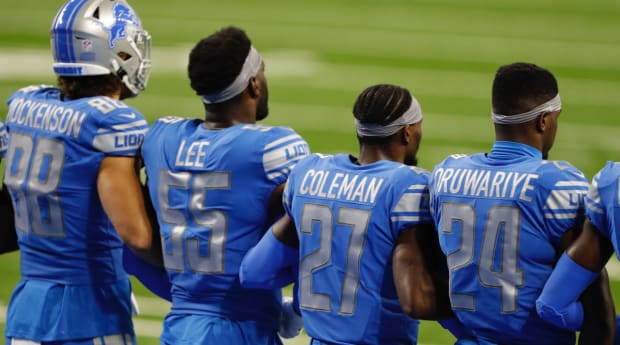Football’s jersey number rules are rooted in some arbitrary choices that don’t always fit positional guidelines.
A few years back, I found myself in an argument with a friend after a Yankees game. After being force marinated in the team’s history for the better part of three hours (go Orioles) the only retort I could find to clap back against one of the most storied franchises in American sports history was how ridiculous it looked that their best player wore No. 99.
It was a half-hearted and meandering point about how the club was so full of itself and retired so many numbers that they’ll have no choice but to have their future best players all wearing hockey numbers (none of the single digits are available anymore, with the lowest available number being 11. Numbers 15, 16, 20, 23, 32, 37, 42, 44, 46, 49 and 51 are also unavailable).
It was also an unsuccessful point because I didn’t believe it. Aaron Judge looks great in No. 99. It’s intimidating. It’s also an enjoyable stylistic clash between traditional, unbothered uniforms and the kind of wild numbers you put on a Ricky Vaughn tribute jersey. Aside from the craft beer tent behind the right field bleachers, it seems to be one of the few things the Yankees have willingly embraced about the world that took place after their halcyon days in the late 1990s.
This is a long way of saying that if the Yankees can embrace this—a franchise so enamored with itself and its tradition that it could be its own Connecticut all-boys school—so can the NFL. There is no excuse.
At their upcoming meetings, owners have the chance to vote on an alteration to the current NFL jersey number restrictions. A proposal from the Kansas City Chiefs asks the league to allow running backs, fullbacks, tight ends and wide receivers to be allowed to wear Nos. 1-49 and 80 to 89, linebackers to wear 1-59 and 90 to 99 and defensive backs to wear any number between 1 and 49. This feels like something that will get a small handful of yes votes and a tidal wave of nays from the cigar-stained country club suits who run the place claiming some kind of faux traditionalism, which will, of course, reflect their actual lack of knowledge about the league they’ve inherited.

A spin through the Hall of Fame charter class shows Sammy Baugh, an accomplished defensive back, quarterback and punter who wore No. 33. Dutch Clark, a running back who wore No. 7. Red Grange wore No. 77. Johnny “Blood” McNally wore Nos. 57, 24, 20, 14, 35, 26, 55 and 15. And while much of this reflects the myriad positions the early players had to fill out during the game’s two-way barnstorming days, the fact remains that football’s traditions are rooted in some arbitrary number choices that don’t always fit positional guidelines.
The current slate of owners meeting rule proposals are great. The Ravens’
brilliant overtime proposal, which would finally introduce some sanity and analytical decision making into the process, is on the docket. Sky Judge, which would allow officials to get help from an individual seeing the game more clearly in the booth, is also, again, mercifully, being set up to get voted down. The Eagles have re-upped the Alliance of American Football style rule that a team can forego an onside kick for a fourth-and-15 attempt at their own 25-yard line.All of these are destined to die on the vine because one of the popular kids will laugh it off as nontraditional and the rest of the crowd, determined to mail it in, will follow suit in hopes of escaping with a quick, no-frills vote.
Allowing players to wear a wider range of numbers, though, cannot be couched as non-traditionalist. Andy Reid, who had downplayed the fourth-and-15 onside kick rule in favor of being an “old guy” admiring the “integrity of the game” coaches the club who proposed allowing defensive backs and running backs to sport single digit jersey numbers. Maybe that is the kind of muscle they’ll need to start turning the tide.
Presumably we’ll hear something about jersey sales; maybe it’s unfair for a kid who bought a Jalen Ramsey jersey (he said he would flip to No. 2), though that point is also largely illogical. Seven of the 10 most popular jerseys sold in the NFL last year were quarterbacks who would be unaffected by the proposal.
Numerical constraints suck so much of the remaining life out of the game. It’s time to loosen our ties and slowly begin to whittle away at the stodginess. The ultimate goal, of course, is to resemble a collegiate game where very large people have stomachs hanging out underneath their single digit jerseys. For now, we'll take something even slightly resembling what the Yankees have in Judge right now; an acknowledgement that things don’t have to look the same forever.


0 Comments